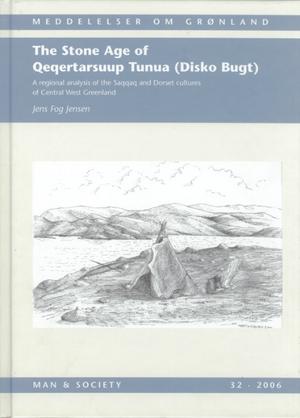The Stone Age of Qeqertasuup Tunua, Disko Bugt

A regional analysis of the Saqqaq and Dorset cultures of Central West Greenland
Meddelelser om Grønland, Man and Society 32, 2006.
Saqqaq and Dorset sites excavated by the author in the southern part of Qeqertarsuup Tunua (Disko Bugt) form the empirical basis for a comparison of Saqqaq and Dorset settlement in the area. Earlier reconstructions of the cultural history were based mainly on observations of stratified middens. In contrast to this, the present work focuses on the 'horizontal dimension' within the archaeological record. As a consequence, settlement patterns, dwelling types and the spatial organisation of dwellings are the principal objectives.
Saqqaq and Dorset settlement patterns are broadly similar and it is concluded that there is little evidence to suggest any major difference in economy or adaptation between the two periods. Both Saqqaq and Dorset settlement patterns are characterised by a number of large settlements located strategically near the most productive biotopes. Minor settlements, most often occupied during the warm season, are found within the catchment area, indicating annual recurring dispersal of the population during the warmer months. Only Sydostbugten, in Southeastern Qeqertarsuup Tunua, appears to exhibit significant differences between Saqqaq and Dorset settlement patterns. Large Dorset settlements have not been found in Sydostbugten and it is suggested that this area, probably due to climatic oscillations, was less attractive for settlement during the Dorset period than it was in the Saqqaq. Consequently, the Dorset people seem only to have utilised Sydostbugten for specialised seasonal camps.
Saqqaq and Dorset accommodation comprises distinct summer and winter dwellings. During both periods, the summer dwellings are characterised by what are believed to be single family tents. These occur in two principal varieties: Tent rings, with a central hearth, and mid-passage tent rings, where the interior is divided in two by parallel lines of stones. This difference in architecture is suggested to result from variation in the social composition of the inhabitants. Winter dwellings of both the Saqqaq and Dorset cultures are characterised by more solidly built structures. In the Saqqaq culture there are 'platform dwellings' and mid-passage structures filled with fire-cracked rocks. During the Dorset, the winter dwellings are characterised by 'double-platform dwellings', in which a central floor area divides the interior into two platforms that are often paved. The presence of more than one hearth or lamp stand, as well as 'mirrored' distributions of the most frequent tool categories to the left and right of the central floor area, is interpreted as a result of these dwellings being occupied by two families.
Chapter 7 focuses on Saqqaq raw material distribution from killiaq sources in the vicinity of Qaarsut and Angissat. The raw material distribution from these two sources is characterised as a regional and local system. The procurement and subsequent distribution of raw materials from Angissat in Southern Qeqertarsuup Tunua appears thus to have been imbedded in the local resource exploitation. Much of the raw material extraction appears to have been carried out by hunting parties visiting the outcrop during summer hunting trips. In contrast to this, Qaarsut at Nuussuaq shows evidence of a more comprehensive production of preforms, which were distributed through-out Western Greenland.
Economically as well as socially, there appear to be numerous similarities between the Saqqaq and Dorset cultures. However, when evaluating the radiocarbon dates, there appears to be discontinuity between the two periods as is also suggested by earlier excavations of stratified deposits. In Sisimiut District, to the south of Qeqertarsuup Tunua, the latest Saqqaq dates overlap with the oldest Dorset dates. Theoretically, there could be continuity between the two periods outside Qeqertarsuup Tunua, however the archaeological evidence for such a development has yet to be found.
When the cultural history of Qeqertarsuup Tunua is compared with that of Peary Land, the dwelling types and chronological units appear very similar. In the case of Dorset and Independence II, the similarities also extend to include the lithic inventory. As a consequence it is difficult to maintain a division between Dorset in Western and Southern Greenland and Independence II in the High Arctic.
